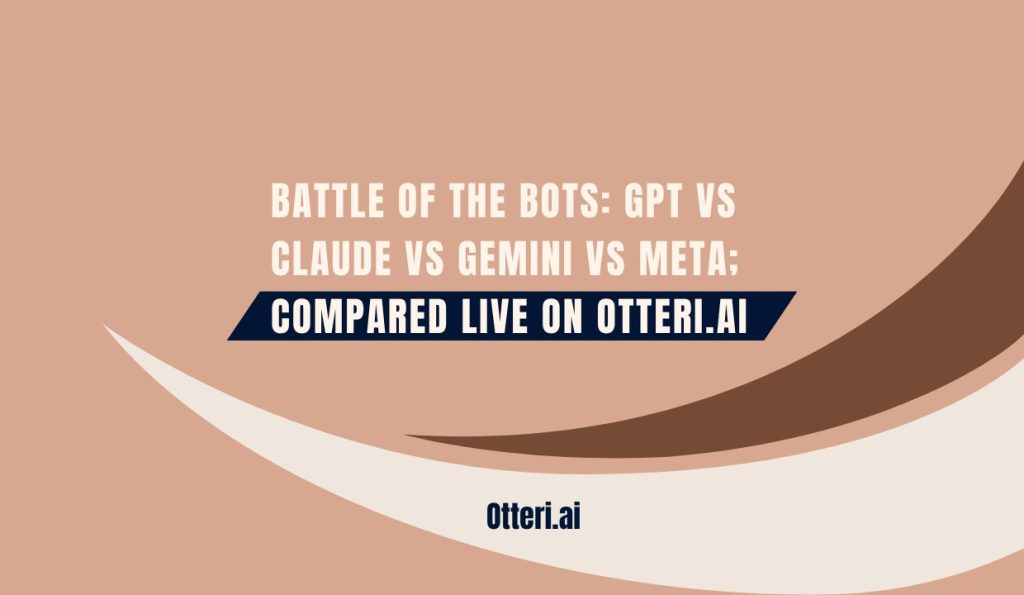
Explore how top AI models, GPT, Claude, Gemini, and Meta, perform on the same prompt using Otteri.ai’s multi-model playground. See which AI gives the best answers and why multi-model prompting is the future.
Artificial intelligence is evolving rapidly, and language models are at the forefront of this transformation. OpenAI’s GPT, Anthropic’s Claude, Google’s Gemini, and Meta’s LLaMA are four of the most powerful AI models available today. Each brings something unique, but how do they perform when given the same prompt?
That’s the question we explore with Otteri.ai’s Playground, a feature that allows users to input a single prompt and instantly receive four different responses—one from each major AI model.
Let’s walk through a live comparison and see how each model stacks up.
What is Otteri.ai’s Playground?
Otteri.ai is a multi-model AI platform that integrates the leading large language models: GPT, Claude, Gemini, and Meta’s LLaMA. The standout feature is the Playground, where users can write one prompt and get responses from all four models side by side. This makes it easier to:
Compare how different models interpret and respond to the same task
Choose the most useful or accurate output
Learn which models are best for specific use cases
Whether you’re creating content, building apps, researching, or experimenting, this tool offers direct insight into how AI models think differently.
The Prompt: “What Will AI Look Like in 2030?”
We tested the following prompt to evaluate reasoning, creativity, and depth:
Prompt: “What will artificial intelligence look like in the year 2030?”
Here’s a summary of how each model responded on Otteri.ai.
GPT (OpenAI)
GPT provided a structured and well-organized prediction. It categorizes AI progress across healthcare, business, education, and entertainment industries. The tone was balanced, and it acknowledged both opportunities and risks.
Highlights:
Easy-to-read layout
Broad and general coverage
Suitable for informative blog content or business insights
Claude (Anthropic)
Claude’s response leaned into philosophical and ethical considerations. It focused on AI alignment, human dignity, global impact, and responsible development. This model highlighted the role of governments and ethics in shaping the future of AI.
Highlights:
Reflective and human-centered
Ideal for policy discussions or editorial content
Less technical, more narrative-driven
Gemini (Google)
Gemini presented a highly futuristic and technical outlook. It included predictions around multimodal AI, real-time assistants, augmented reality, and neural interfaces. The response leaned heavily into innovation and emerging technologies.
Highlights:
Bold and imaginative
Detailed technological references
Best for forward-thinking or speculative content
Meta (LLaMA)
Meta’s response took an academic tone. It emphasized open-source development, decentralized AI research, and community-driven progress. It felt more like a research brief than a creative essay.
Highlights:
Precise and structured
Appeals to developers and researchers
Not as engaging for general audiences
Choosing the Best Model
There’s no one-size-fits-all winner. Each model shines in different scenarios:
GPT is great for clear, general-purpose content.
Claude is better for thoughtful, ethical, or policy-oriented responses.
Gemini excels in futuristic and technical explorations.
Meta delivers clean, research-style output suitable for scholarly use.
This is exactly where Otteri.ai stands out. Instead of forcing you to choose one model upfront, you get to see them all and select the best response for your specific needs.
Why Multi-Model Prompting Matters
In most AI platforms, you’re tied to one model. But in reality, no single AI is perfect across every use case. With Otteri.ai, the ability to compare four leading models in real time allows users to:
Avoid bias or limited perspectives
Cross-check factual accuracy
Generate diverse content ideas
Understand how different AI models reason
It transforms prompting from a guessing game into a decision-making tool.
Use Cases You Can Explore
Here are some ways users can benefit from Otteri’s Playground:
Content creators can test four angles for the same article topic
Researchers can compare technical explanations across models
Developers can evaluate code output from multiple engines
Educators can find the clearest way to explain complex topics
Prompting becomes smarter when multiple AI minds weigh in.
Looking Ahead
Otteri.ai continues to evolve. Upcoming features include:
Session history and bookmarking
Model analytics and performance tracking
Workspace sharing for teams
API access for multi-model development
As the AI landscape grows, Otteri.ai aims to be the command center where users harness the strengths of multiple models without switching tools or platforms.
Conclusion
The “Battle of the Bots” isn’t about picking one champion—it’s about recognizing the strengths and styles of each major AI model. Otteri.ai empowers users by making these comparisons live, visible, and useful.
With Otteri.ai, you get the full spectrum—and the final choice is yours.
Try it out at Otteri.ai and start your own AI comparisons today.